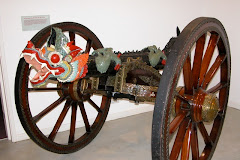It's quite common to hear people, especially in the media, referring to any tracked vehicle with a gun as a 'tank'. They are demonstrating their ignorance! There are so many points of difference that it's perhaps worth taking a moment to look at them.
First, the roles of a tank and a self-propelled gun are completely different. A tank is designed to operate in contact with the enemy and needs to have the mobility, the protection and the firepower for this role. A self-propelled gun is an artillery weapon and has to be capable of engaging the enemy across a wide sector of the front and in depth, working together with other artillery pieces to produce a great weight of fire on the chosen target.
A tank's gun is designed to knock out other tanks and fires high velocity projectiles that can penetrate very thick armour plate. It has other types of ammunition as well, but it is this high velocity role that drives the design of a weapon that has a very flat trajectory and superb sighting systems. Its armour is especially designed for protection against most forms of direct fire and that armour is concentrated on the front of the tank, facing the enemy. As a result, it is normal for tanks to have their engines in the rear, protected by all the frontal armour and out of harm's way. The thick armour means that tanks tend to be very heavy and the amount of space inside the turret very limited, in turn limiting the amount of ammunition that can be carried. However, tanks do not expect to have to fire large amounts of ammunition and their guns wear quite quickly - in this respect they are very different from artillery weapons.
A self-propelled (SP) gun does not need heavy frontal armour because it is not in direct contact with the enemy, but sited some 3 - 6 Km behind the front lines where its lighter armour provides adequate protection from shell fragments and small arms fire. Its artillery role means that it is required to be able to fire a lot of ammunition, so its carrying capacity is much greater than that of a tank. It may well fire in excess of 300 rounds during a single day and feeding ammunition into the turret is a major factor in its operation. It is a great help to be able to open the rear of the chassis to allow easy access, but that cannot be achieved with a rear-mounted engine, so that's usually in the front of the chassis, unlike the tank.
Both types of vehicle require good mobility, but in a tank it can be particularly important for its effectiveness and, sometimes, for its survival. Tanks tend therefore to have very powerful engines, not only for speed but also to cope with their weight in cross-country conditions.
The list could go on, but perhaps I could end with a fundamental difference - their sighting systems are completely different. Where tank sights are designed to deal with targets at direct fire, SP gun sights are intended to deal with targets at long range and out of sight.




If a tank is supposed to knock out other tanks, yet is protected against that happening, how do tanks get knocked out?
ReplyDeleteGood question! Tank armour isn't guaranteed infallible and there's a constant battle between improvements in protection versus improvements in firepower. The latest Western tanks have amazing firepower, but some of the improvements in armour are equally amazing in resisting penetration, so it often comes down to who gets in the first hit! Much also depends on where a tank is hit: the sides carry less armour and you can't be certain of presenting only your front to the enemy in manoeuvre warfare.
ReplyDelete